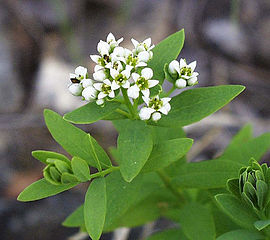- Comandra
-
Comandra

Comandra umbellataClasificación científica Reino: Plantae División: Magnoliophyta Clase: Magnoliopsida Orden: Santalales Familia: Santalaceae Género: Comandra
Nutt.Especie: C. umbellata Nombre binomial Comandra umbellata
(L.) Nutt.Sinonimia - Comandra richardsiana Fern.
- Thesium umbellatum L.
Comandra es un género de la familia Santalaceae que contiene una única especie, C. umbellata, con cuatro subespecies distribuidas en Norteamérica y la región del Mediterráneo.[1] C. umbellata está considerada como semi parásito.
Características
Comandra es una pequeña planta herbácea que vive como parásito en las raíces de otras plantas y tienen diminutas flores blancas.[2]
Comandra no está obligada a ser parásita desde que obtiene sus nutrientes por fotosíntesis, sin embargo tiene una amplia relación de plantas huéspedes, tales como Aster, Antennaria, Solidago, varias especies de arbustos como, Rosa, Rubus, Fragaria, Vaccinium, y varias especies de árboles como Acer, Betula, Populus, y Carex, y varias hierbas.[3]
Referencias
- ↑ Mabberley, DJ (2000). The Plant Book: A portable dictionary of the vascular plants. Cambridge University Press.
- ↑ Eckel, P. M. (2000). «Tiny Species: Myosotis stricta Link, A Rare Component of Some Vernal Microfloras in New York and Ontario along the Niagara River». Clintonia 16 (1): pp. 4. http://www.mobot.org/plantscience/ResBot/niag/misc/tinyspecies.pdf.
- ↑ Moss, E. H. (1926). «Parasitism in the genus Comandra». New Phytologist 25: pp. 264–276.
Enlaces externos
- http://calphotos.berkeley.edu/cgi/img_query?where-genre=Plant&rel-namesoup=like&where-namesoup=Comandra
 Wikimedia Commons alberga contenido multimedia sobre Comandra. Commons
Wikimedia Commons alberga contenido multimedia sobre Comandra. Commons
 Wikiespecies tiene un artículo sobre Comandra. Wikispecies
Wikiespecies tiene un artículo sobre Comandra. Wikispecies
Wikimedia foundation. 2010.
